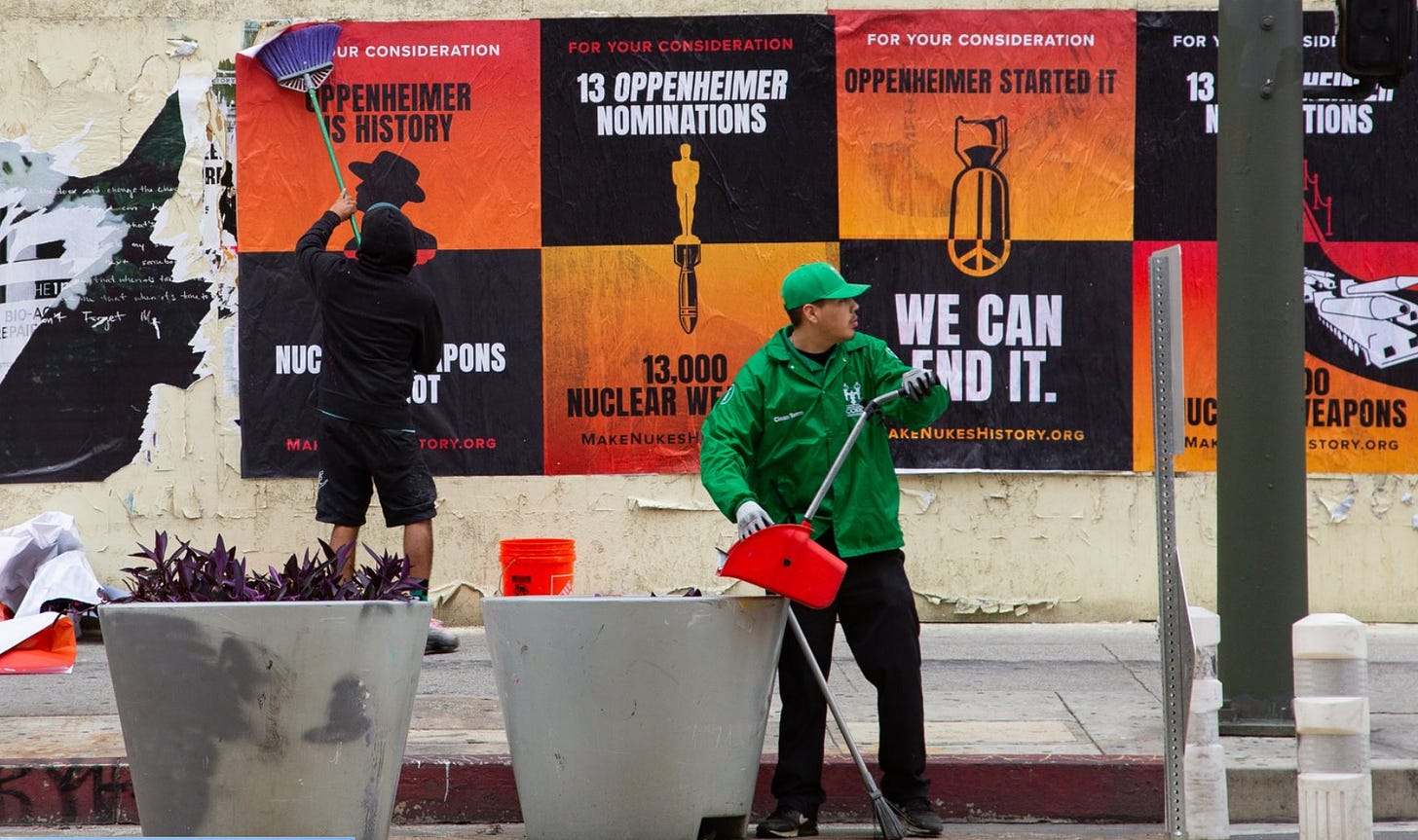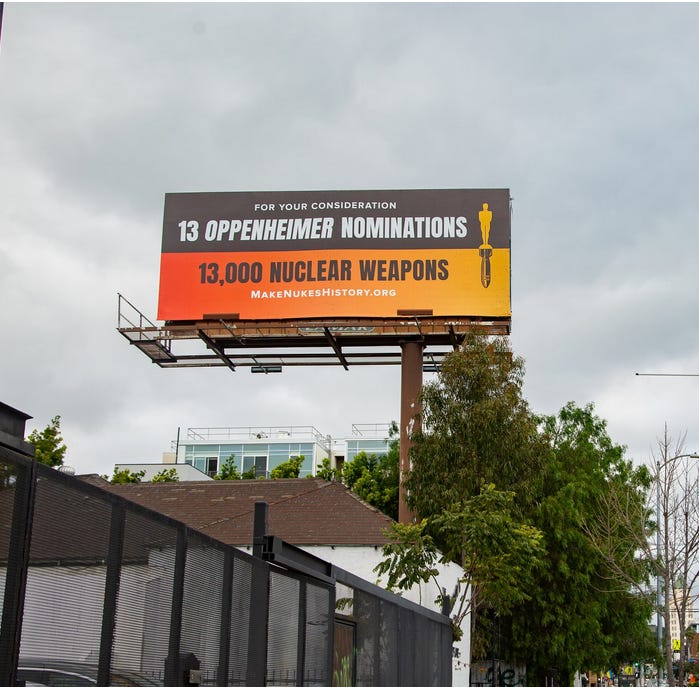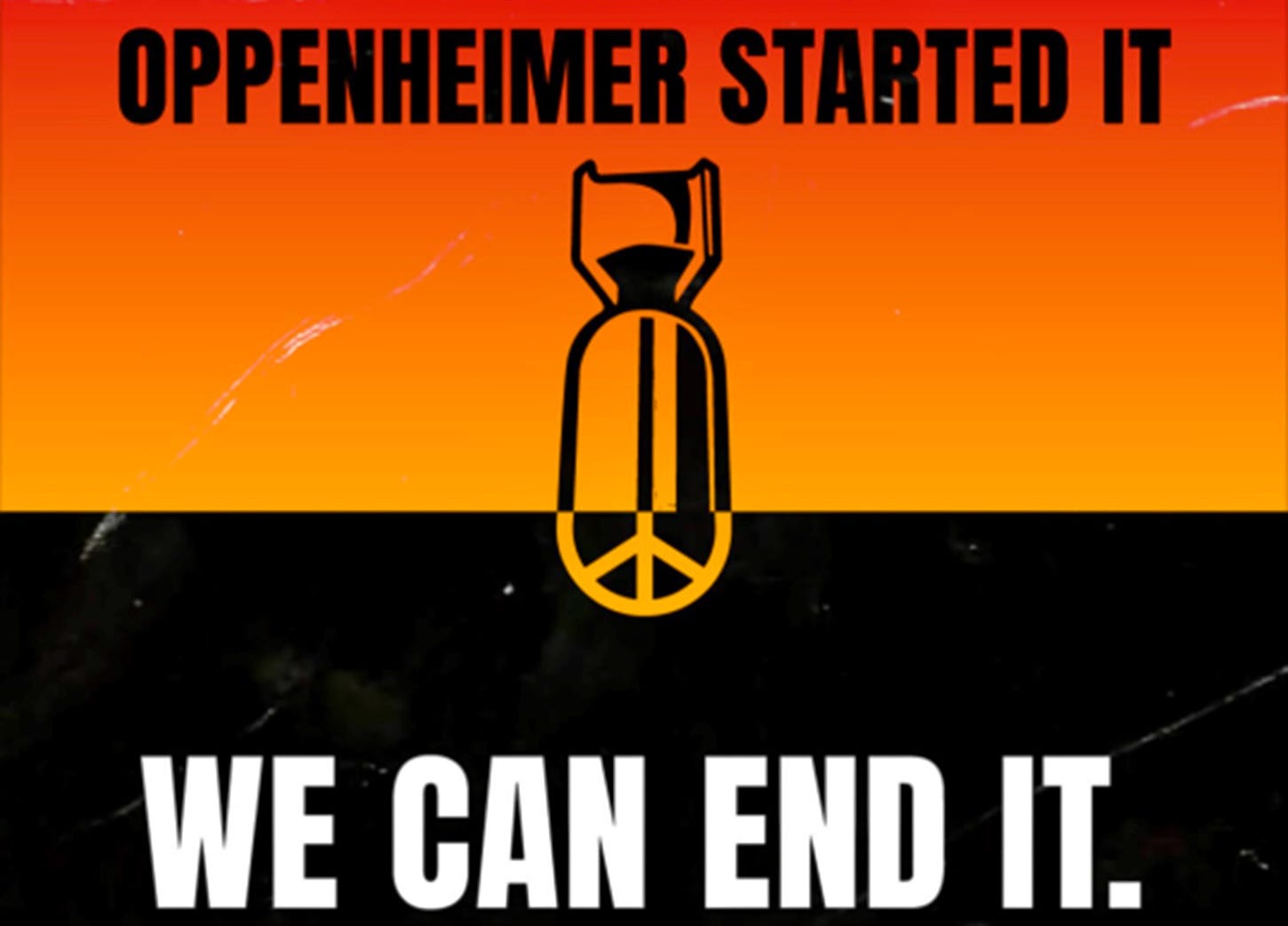Reprinted with permission from Greg Mitchell’s newsletter Oppenheimer: From Hiroshima to Hollywood.

When Christopher Nolan’s Oppenheimer was released last July, many predicted it would spark profound and long-lasting new activism, and official measures, with the aim of reducing nuclear risks and eliminating more of the weapons, perhaps down to zero. I cast doubt on this optimism, as I found the film far too weak in its messaging and its failure to truly confront the only use of the weapons in war and provide crucial lessons for today. Sadly, beyond a great number of articles, columns, TV segments, posts and special issues, a strong new antinuclear movement has failed to materialize and positive official actions have been few and far between.
This afternoon, I was interviewed for the public radio “World” national program for a segment on Oppenheimer shortcomings (which I have detailed at this Substack since early last July). You can listen to the 8-minute segment here.
Yet, all the while, nuclear threats are only increasing, as a massive New York Times interactive report – the first of a series – started detailing this week (see more down the page a bit) It is accompanied by an intro from opinion editor Kathleen Kingsbury with the headline: “It’s Time To Protest Nuclear War Again.”
As it happens, with the Oscar ceremony just three days off, and Oppenheimer certain to be a big winner, some Hollywood stars, musicians and others are finally uniting again against The Bomb. Some of us old enough recall similar celeb rallying in the early 1960s and 1980s.
Here’s how USA Today covered it this morning:
Stars are banding together ahead of the 2024 Oscars on Sunday to call for the end of nuclear weaponry, including “Oppenheimer” cast members Matthew Modine and Tony Goldwyn.
Modine, Goldwyn, Michael Douglas, Jane Fonda, Lily Tomlin, Lisa Rinna, Kristen Stewart, Emma Thompson and Yvette Nicole Brown are among the celebrities who signed an open letter calling to “make nukes history.”
“Every person should be educated about the incredible destructive power of nuclear weapons. Understanding the threat illuminates a necessary path toward their elimination,” said Modine in a press release shared by the Nuclear Threat Initiative. “Hundreds of thousands of Americans have been directly harmed by radioactive fallout from the hundreds of nuclear explosions conducted on US soil.”
The site for the protest includes the full statement and list of signees, which also include old standbys Jackson Brown, Graham Nash, and Annie Lennox, as well as Bill Nye, Julianne Moore and… more. Oppenheimer’s grandson and activist Charles Oppenheimer also signed the open letter. The site also offers numerous ways to “take action.” And links to that new New York Times special.
“Oppenheimer was right to warn us. Today, 13,000 nuclear weapons are held by nine countries. Some are 80 times more powerful than the ones that destroyed Hiroshima and Nagasaki in 1945,” the open letter states in part. “As artists and advocates, we want to raise our voices to remind people that while Oppenheimer is history, nuclear weapons are not.” So the aim is abolition.
The “Make Nukes History” campaign kicks off tomorrow in Los Angeles with billboards, art installations, murals and over 1,000 street posters.


Back to that New York Times special report: It’s far too long to summarize here but I will get to some of that in a few days. The online package includes extensive and startling animation, charts, and video. The first installment, aptly titled The Brink, is written by one of their national security analysts, W.J. Hennigan. It opens in a chilling fashion with some new evidence:
If it seems alarmist to anticipate the horrifying aftermath of a nuclear attack, consider this: The United States and Ukraine governments have been planning for this scenario for at least two years.
In the fall of 2022, a U.S. intelligence assessment put the odds at 50-50 that Russia would launch a nuclear strike to halt Ukrainian forces if they breached its defense of Crimea. Preparing for the worst, American officials rushed supplies to Europe. Ukraine has set up hundreds of radiation detectors around cities and power plants, along with more than 1,000 smaller hand-held monitors sent by the United States.
Nearly 200 hospitals in Ukraine have been identified as go-to facilities in the event of a nuclear attack. Thousands of doctors, nurses and other workers have been trained on how to respond and treat radiation exposure. And millions of potassium iodide tablets, which protect the thyroid from picking up radioactive material linked with cancer, are stockpiled around the country.
But well before that – just four days after Russia launched its invasion of Ukraine, in fact – the Biden administration had directed a small group of experts and strategists, a “Tiger Team,” to devise a new nuclear “playbook” of contingency plans and responses. Pulling in experts from the intelligence, military and policy fields, they pored over years-old emergency preparedness plans, weapon-effects modeling and escalation scenarios, dusting off materials that in the age of counterterrorism and cyberwarfare were long believed to have faded into irrelevance.
The playbook, which was coordinated by the National Security Council, now sits in the Eisenhower Executive Office Building, next to the West Wing of the White House. It has a newly updated, detailed menu of diplomatic and military options for President Biden – and any future president – to act upon if a nuclear attack occurs in Ukraine.
At the heart of all of this work is a chilling conclusion: The possibility of a nuclear strike, once inconceivable in modern conflict, is more likely now than at any other time since the Cold War. “We’ve had 30 pretty successful years keeping the genie in the bottle,” a senior administration official on the Tiger Team said. While both America and Russia have hugely reduced their nuclear arsenals since the height of the Cold War, the official said, “Right now is when nuclear risk is most at the forefront.”
Russian President Vladimir Putin reminded the world of this existential danger last week when he publicly warned of nuclear war if NATO deepened its involvement in Ukraine.
Thanks for reading Oppenheimer and the Legacy of His Bomb ! Subscribe for free to receive new posts and support my work.
Greg Mitchell is the author of a dozen books, including “Hiroshima in America,” and the recent award-winning The Beginning or the End: How Hollywood – and America – Learned to Stop Worrying and Love the Bomb, and has directed three documentary films since 2021, including two for PBS (plus award-winning “Atomic Cover-up”). He has written widely about the atomic bomb and atomic bombings, and their aftermath, for over forty years. He writes often at Oppenheimer: From Hiroshima to Hollywood.
